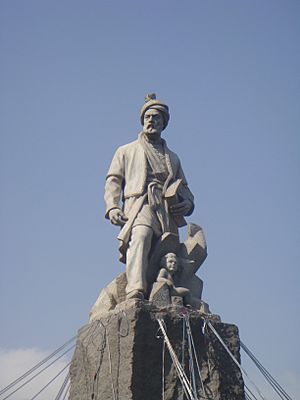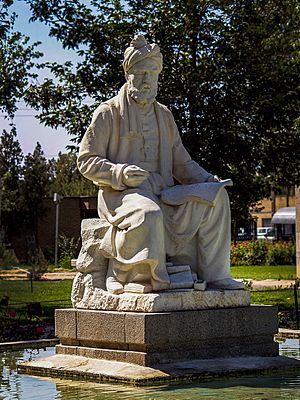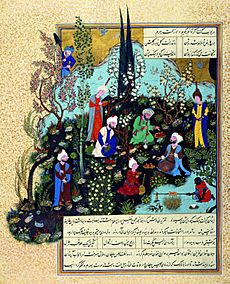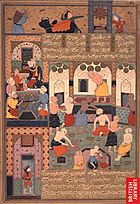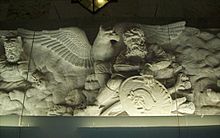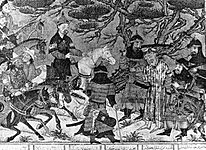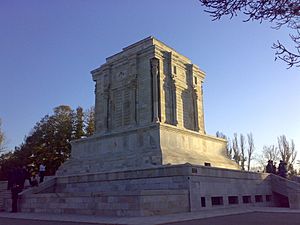Ferdowsi facts for kids
Quick facts for kids
Ferdowsi
فردوسی |
|
|---|---|
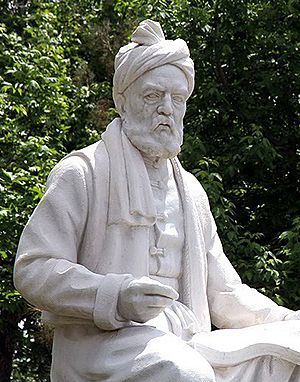
Statue of Ferdowsi in Tus by Abolhassan Sadighi
|
|
| Native name |
Persian: ابوالقاسم فردوسی توسی
|
| Born | 940 Tus, Samanid Empire |
| Died | 1019 or 1025 (87 years old) Tus, Ghaznavid Empire |
| Occupation | Poet |
| Language | Early Modern Persian |
| Period | Samanids and Ghaznavids |
| Genre | Persian poetry, national epic |
| Notable works | Shahnameh |
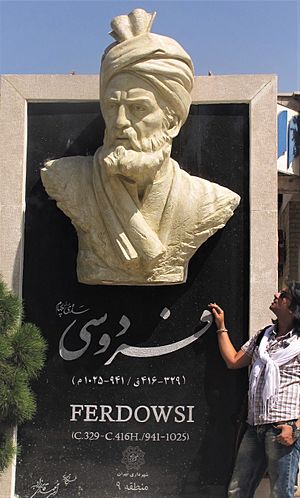
Abul-Qâsem Ferdowsi Tusi (born 940 – died 1019 or 1025 CE) was a famous Persian poet. He wrote the Shahnameh, also known as the "Book of Kings." This book is one of the longest epic poems ever written by one person. It is also the most important epic in Persian-speaking countries. Ferdowsi is seen as one of the most important people in Persian literature. Many people consider him one of the greatest writers in history.
Contents
Who Was Ferdowsi?
Ferdowsi's full name was Abul-Qâsem Ferdowsi Tusi. His last name, Ferdowsi, means 'paradisic' or 'from paradise'. He is often called Hakim, which means "philosopher." So, his full name is often given as Hakim Abo'l-Qâsem Ferdowsī Țusī. You might see his name spelled in different ways in English, like Firdawsi or Firdausi. This is because it's hard to write Persian sounds perfectly in English letters.
Ferdowsi's Life Story
His Family and Home
Ferdowsi was born in 940 CE in a village called Paj. This village was near the city of Tus. Tus was in the Khorasan region of the Samanid Empire. Today, this area is in northeastern Iran.
His family were landowners called dehqans. These were important Iranian families who owned land. They had been powerful for a long time, even before Islam came to Iran. Ferdowsi had a wife, who could probably read and write. He also had a son, who sadly died when he was 37 years old. Ferdowsi wrote a sad poem about his son's death and put it in his famous book, the Shahnameh.
His Background and Times
The dehqans were very proud of Iran's history before Islam. They felt it was their job to keep old stories and traditions alive. This included tales about ancient kings.
In the 7th century, Islamic armies conquered Iran. This brought new languages and cultures. By the late 800s, the power of the caliphate (Islamic empire) became weaker. New local rulers appeared in Iran. Ferdowsi grew up in Tus, which was ruled by the Samanid dynasty. The Samanids used the New Persian language. They also asked people to translate old Persian texts into New Persian.
A governor named Abu Mansur Muhammad asked scholars to gather old stories. They created a prose (story-like) Shahnameh in 1010. Ferdowsi used this book as one of his sources. The Samanid rulers also supported other great Persian poets. Ferdowsi followed in their footsteps. We don't know much about Ferdowsi's education. But from his Shahnameh, it seems he didn't know Arabic or Pahlavi (an older Persian language).
Life as a Poet
Ferdowsi probably wrote some poems when he was young. But these poems have not survived. He started working on the Shahnameh around 977 CE. He wanted to continue the work of another poet named Daqiqi. Daqiqi had started an epic poem but was killed. Ferdowsi used the prose Shahnameh as a source, just like Daqiqi.
He received support from a Samanid prince named Mansur. Ferdowsi finished the first version of the Shahnameh in 994 CE. Later, the Turkic Ghaznavids took over from the Samanids. Ferdowsi kept working on his poem. He even changed parts to praise the Ghaznavid ruler, Sultan Mahmud.
There are many stories about how Sultan Mahmud treated Ferdowsi. Some parts of the Shahnameh show Ferdowsi's feelings. He sometimes wrote about being old, poor, or sick. He also wrote about his son's death. Other times, he seemed happier. Ferdowsi finally finished his epic poem on March 8, 1010. We don't know much about the last ten years of his life.
Ferdowsi's Tomb
Ferdowsi was buried in his own garden. A local religious leader had forbidden him from being buried in the public cemetery. A Ghaznavid governor built a special building over his grave. This place became very respected.
The tomb eventually fell apart. But it was rebuilt between 1928 and 1934. This was ordered by Reza Shah, a ruler of Iran. Today, the tomb is like a national shrine. It is a very important place for Iranians.
The Legend of Ferdowsi and Sultan Mahmud
There is a famous legend about Ferdowsi and Sultan Mahmud of Ghazni. The story says that Sultan Mahmud promised Ferdowsi a gold coin for every two lines of poetry he wrote. Ferdowsi agreed to get all the money when his epic was finished. He planned to use the money to fix the water dams in his hometown of Tus.
After thirty years, Ferdowsi finished his great work. The sultan was ready to give him 60,000 gold coins, as promised. But the courtier (a person who worked for the sultan) who was in charge of the money did not like Ferdowsi. He thought Ferdowsi was a heretic (someone with different religious beliefs). So, he secretly replaced the gold coins with silver ones.
Ferdowsi was in a bathhouse when he received the payment. When he saw it was silver, not gold, he gave all the money away. He gave it to the bath-keeper, a seller of drinks, and the slave who carried the coins. When the courtier told the sultan what Ferdowsi did, Mahmud was very angry. He threatened to kill Ferdowsi.
Ferdowsi quickly ran away to Khorasan. Before he left, he wrote a poem making fun of Sultan Mahmud. He spent most of his remaining life in exile. Eventually, Sultan Mahmud found out the truth about the courtier's trick. He punished the courtier, either by sending him away or executing him. By this time, the old Ferdowsi had returned to Tus.
The sultan sent a new gift of 60,000 gold coins to Ferdowsi. But as the caravan carrying the money entered Tus, a funeral procession left the city from the other side. Ferdowsi had died from a heart attack.
Ferdowsi's Works
Ferdowsi's Shahnameh is the most famous and important national epic in Iran. It is also very popular in other Persian-speaking countries. The Shahnameh is the only work by Ferdowsi that we are sure he wrote.
He might have written other poems earlier in his life. But they do not exist anymore. There was a story poem called Yūsof o Zolaykā (Joseph and Zuleika) that some thought he wrote. But most scholars now believe he did not write it.
People also wonder about the poem Ferdowsi supposedly wrote to insult Sultan Mahmud. An early writer about Ferdowsi said that almost all of this poem was destroyed. Some copies of the Shahnameh include verses that are said to be this poem. Some experts think these verses are fake. Others believe they might be real.
Gallery
-
The Sasanian King Khusraw and Courtiers in a Garden, from a Shahnameh manuscript
-
A scene from the Shahnameh showing the Parthian king Artaban facing the Sassanid king Ardashir I
Ferdowsi's Lasting Influence
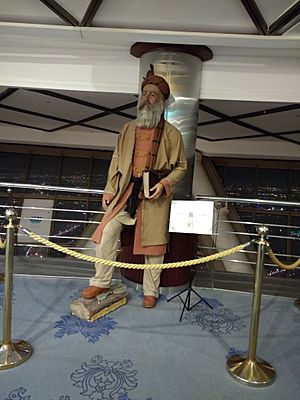
Ferdowsi is one of the most important figures in Persian literature. After his Shahnameh, many other similar works were written. They all tried to be like Ferdowsi's masterpiece. But none of them became as famous or loved as the Shahnameh.
Ferdowsi is special in Persian history. He helped bring back and strengthen the Persian language and culture. His work is key to why the Persian language still exists today. It helped keep the language organized and complete. Many modern Iranians call him the father of the modern Persian language.
Ferdowsi also inspired many future Persian leaders. One such leader was Reza Shah Pahlavi. He created an Academy of Persian Language and Literature. This group tried to remove Arabic and French words from Persian. They wanted to replace them with Persian words. In 1934, Reza Shah held a big event in Mashhad to celebrate 1,000 years of Persian literature since Ferdowsi's time. It was called the "Ferdowsi Millennial Celebration." Many scholars from Europe and Iran attended. Ferdowsi University of Mashhad, founded in 1949, is also named after him.
The Encyclopædia Britannica explains Ferdowsi's influence:
- The Persians think Ferdowsi is their greatest poet. For almost a thousand years, they have read and listened to parts of his main work, the Shahnameh. This book gave the Persian national epic its final and lasting form. Even though it was written about 1,000 years ago, modern Iranians can understand it easily. The language is pure Persian, with only a few Arabic words mixed in.
There is also a library at Wadham College, Oxford University, named the Ferdowsi Library. It has a special section for scholars studying Persian.
See also
 In Spanish: Ferdousí para niños
In Spanish: Ferdousí para niños
- Iranian Studies
- Ferdowsi millennial celebration
- Ferdowsi University of Mashhad
- List of Persian poets and authors
- Persian literature
- Sassanid Empire
- List of mausoleums
- Jerry Clinton (1937–2003), US Ferdowsi scholar
- Ferdowsi (1934 film)


